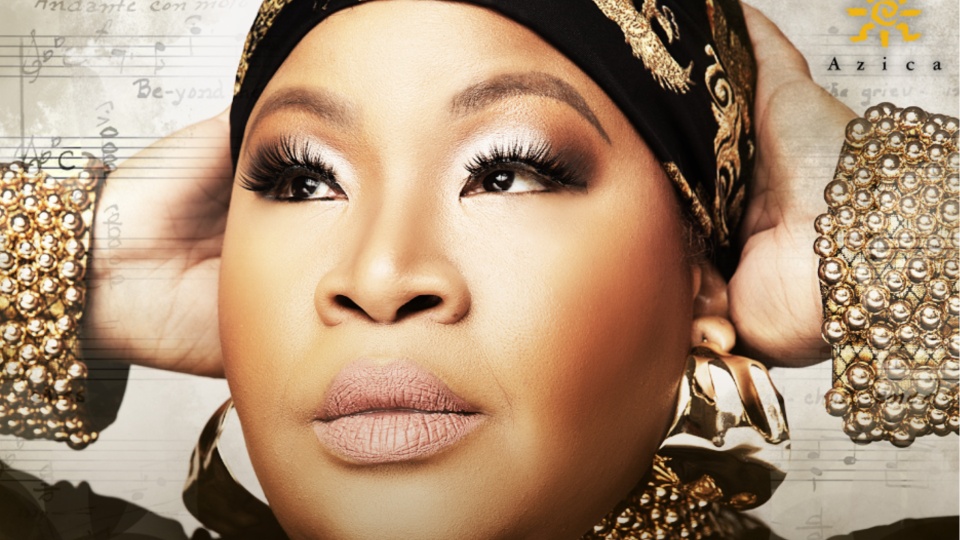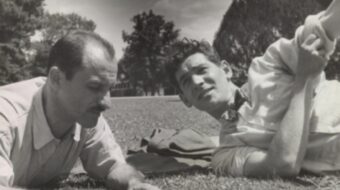
Last year, a hardworking music publicist alerted me to a rare performance of Damien Geter’s spirituals-based Justice Symphony up in Fresno, paired with Beethoven’s 9th, and I took the bait. The amazing soprano soloist (in both) was Karen Slack, who is presently enjoying a stellar career (about which said publicist continues to inform me). She’s got a website (naturally) where you can learn more. It’s all the way cross country for me, but I sure would love to see her in Geter’s forthcoming opera Loving v. Virginia, about the eponymous interracial marriage Supreme Court case, with Virginia Opera next Spring.
Karen Slack has just released her debut album, showcasing just her solo voice, her fine piano accompaniment by Michelle Cann (www.michellecann.com), and 19 unpublished songs by African-American composer Florence Price, including 16 world premiere recordings. Beyond the Years: Unpublished Songs of Florence Price was produced by Alan Bise and ONEcomposer, an organization that celebrates musicians whose legacies have been historically excluded.
ONEcomposer states, “The opportunity to hear Price’s songs performed by industry leaders positions her where she belongs– alongside the great art song composers. Karen Slack is one of the most gifted communicators in her industry, and her versatility in presenting recitals, chamber music, and opera is exceptional. Michelle Cann has been championing the works of Florence Price for many years. This album is advocacy. It is an invitation to performers, educators, musicologists, and anyone with curiosity to continue the work of fully realizing Price’s legacy.”
Space does not permit comment on each of the 19 songs. Generally speaking—at least in this selection of songs out of an estimated 150-plus that she wrote—Price seems drawn to meditative ruminations on great themes such as life, death, love, remembrance and nature. Her choices of poets and lyrics reveal much about her character as a composer. Although she incorporated certain African-American musical elements in her work, these do not dominate here for the most part. Florence Price (1887-1953) aimed to succeed as an American composer, not wishing to be pigeonholed as solely a niche African-American composer. Only the occasional blue note creeps into this album. Even the texts by Black poets do not necessarily evoke the classic tropes of blues, spirituals or jazz, or the themes of race, prejudice and resistance. Her musical idiom is largely that of the turn-of-the-20th-century art song—a little Brahms, a little Debussy, a little Hugo Wolf.

In “Ships that Pass in the Night,” at 3:58 the longest of her songs on the total album length of 53:31, Price sets a Paul Laurence Dunbar poem about the open seas, a passing ship as a premonition of death, fear, terror of the unknown:
O Earth, O Sky, O Ocean, both surpassing,
O heart of mine, O soul that dreads the dark!
Is there no hope for me? Is there no way
That I may sight and check that speeding bark
Which out of sight and sound is passing, passing?
It bears mentioning that in the album booklet, the verses are printed in a dated typewriter font, suggesting the period of their creation.
“Pittance,” to a text by Don Vincent Gray, recalls Bach’s cantata Ich habe genug (“I have enough”), not so much a lament as the resigned and even joyous anthem of the poor:
The walls are thin, but warm within and held against the dim
We have enough though shelves be bare of things to eat…
We have enough.
Dunbar’s lyric “The Sum” would seem to anticipate the Ira Gershwin lyric for the Porgy and Bess song “I Got Plenty of Nothin’” but with a little ironic twist after a summation of life’s course at the end:
A little dreaming by the way
A little toiling day by day;
A little pain, a little strife,
A little joy, and that is life….
Just dreaming, loving, dying, so,
The actors in the drama go—
A flitting picture on the wall,
Love, Death, the themes; (and that is all) but is that all?
The passage in parentheses was added by Price. One can only think of the great Lieber and Stoller song that Peggy Lee nailed to her eternal fame, “Is That All There Is?”
Songs 9 and 10 seem purposely juxtaposed for their contrasting moods. “What Do I Care for Morning,” set to words by Helene Johnson in a folklike melody, is an ode to dark night, “tender and yielding,” as opposed to the “naked and newly born” day. It’s followed by Otto Leland Bohanan’s text “The Dawn’s Awake,” that celebrates “the new awakening” and perhaps can be read as a social commentary. It was published in The Book of American Negro Poetry in 1922, an anthology edited by James Weldon Johnson. Its final stanza goes:
The Dawn’s awake!
Whispers of pent up harmonies,
With the mingled fragrance of the trees;
Faint snatches of half-forgotten song—
Fathers! Torn and numb—
The boone [sic] of light we craved, awaited long,
Has come, has come!
“Beyond the Years,” the Dunbar poem that lends its title to the album, speaks of the answered prayers, the smiles, the rest that wait us in eternity, in that sense thematically, though not in musical form, echoing the sentiment for a better hereafter in a traditional spiritual. Its third stanza reads:
Beyond the years the soul shall find
That endless peace for which it pined,
For light appears,
And to the eyes that still were blind
With blood and tears,
Their sight shall come all unconfined
Beyond the years.
In Irish poet James Stephens’ “Little Things,” the poet seems to recapitulate the Lord’s prayer as though rewritten by the environmentally conscious St. Francis:
As we forgive those done to us,
The lamb, the linnet, and the hare,
Forgive us all our trespasses
Little creatures everywhere.
I can’t be sure what exactly was Florence Price’s cosmology of faith, though there seem to be many evocations of nature in her work. In “Your Leafy Voice,” a poem by Marion Doyle, she adopts a supremely humanistic philosophy, employing here an unusual (for her) French-inspired chromaticism that seemingly takes in all the shimmering harmonies of a sun-dappled forest:
May I who so loved woodlands,
When my body goes back to nourish grasses,
The nettle and rose,
Find your hand outstretched to guide
My bewildered spirit back,
Down the path of the wind,
And the blinding zodiac,
To some wooded hillside slope
Such as now I see,
And crying in your leafy voice,
Open sesame!
Bid my homing spirit
Welcome to a tree.
In “Song is So Old,” set to a poem by Hermann Hagedorn, Price indulges her hunch that in the end—and it is the final song on the album—perhaps music can never adequately communicate feeling so well as a new love, even as its “warm blood” “sings unheard.”
It seemed odd, but maybe fitting, that in “Spring,” which Price set to her own poetry in about 1913, when she was 26, she achieved, to my hearing, the most successful prosody, or word setting, in the whole collection. Its theme is ecstasy—the dream, the song, the pain. Here, perhaps, more than anywhere else, she consummated the perfect marriage of word and note that I found not so constant in other songs. As one listens to all 19 numbers on the album, her settings, workmanlike and all too similar in arty tone, barely differentiate in character, her prosody often sounding arbitrary, reaching for emphatic high notes on illogical words.
I hear this particular album as an incredibly important document not only of these previously unknown corners of Price’s output, but also as a thrilling calling card for Ms. Slack’s artistry. I believe most listeners, however—unless they are fellow singers in search of new material from a sorely bypassed talent—will feel a sense of tedium setting in before the album is half through. While a whole concert of Price songs might not be marketable, a set of them on a program—about nature, or death, or the love of life, for example—would certainly be a welcome and long postponed addition.

The academic apparatus in the album booklet, written by Dr. Stephen Spinelli and Tamara Acosta, is itself an elegant accomplishment. Each variation from the poet’s original text that the composer has employed (often for rhythm) is dutifully noted. The archival research for each song is carefully curated, with cited sources dating from as recently as April 2024, including the location of each extant manuscript, mainly in the Florence Beatrice Smith Price Papers at the University of Arkansas, Fayetteville.
And I found the brief biographies of the poets most illuminating. A very few, like Lord Byron, represented twice, are well known to the literary public. Paul Laurence Dunbar (1872-1906) is an established name in Black literature, and he is represented three times. But other names were new to me: Diligent students have resurrected their careers and where they published their work. Not all were Black, of course: Price drew upon whatever struck her fancy. Among the African-Americans, whose work often appeared in The Crisis, the NAACP’s magazine, as well as in mass-circulation magazines, we come across the lyrics of Helene Johnson (1906-1995), who was active in the Harlem Renaissance; Otto Leland Bohanan (1895-1932), a music teacher at the DeWitt Clinton High School in New York City; Georgia Douglas Johnson (1877 or 1880-1966), who, in the words of W.E.B. Du Bois, “was liable at any time or anywhere to turn out some little thing of unusual value or beauty”; Louise Charlotte Wallace, a friend of the composer in Arkansas, about whom not a great deal is known; and Virginia Houston, who worked in social services in Cleveland, Ohio, and whose biographical information is also scant.
Others, ethnic background unclear, include the blind poet Orma Jean Surbey (1896-1967) and Don Vincent Gray (1912-1991), who was a tool and die maker for the Parker Pen Company and also published his poetry. Caucasian poets include Lithuanian-born Samuel Hoffenstein (1890-1947), author of four books of poetry as well as credits on Hollywood screenplays (The Wizard of Oz, Dr. Jekyll and Mr. Hyde, and Laura); David Morton (1886-1957), a colleague of Robert Frost at Amherst College; the Irish poet and novelist James Stephens (1880-1950); Marion Doyle (1898-1974), “Poet Laureate of Somerset County,” Penn.; and Hermann Hagedorn (1882-1964), who, alongside his poetic success also wrote eight books on the life of Theodore Roosevelt, with whom he was close friends.
In short, this is a laudable achievement.
To listen to excerpts from the album, click here.
Beyond the Years: Unpublished Songs of Florence Price
Karen Slack, soprano; Michelle Cann, piano
Recorded at Sauder Concert Hall, Goshen College, September 8-10, 2023
Azica Records ACD-71370
We hope you appreciated this article. At People’s World, we believe news and information should be free and accessible to all, but we need your help. Our journalism is free of corporate influence and paywalls because we are totally reader-supported. Only you, our readers and supporters, make this possible. If you enjoy reading People’s World and the stories we bring you, please support our work by donating or becoming a monthly sustainer today. Thank you!










